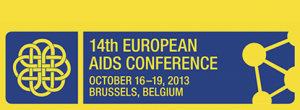Cenicriviroc: 48 week results compared to efavirenz
1 December 2013. Related: Conference reports, Antiretrovirals, EACS 14 Brussels 2013.
 Simon Collins, HIV i-Base
Simon Collins, HIV i-Base
Cenicriviroc is a CCR5 inhibitor (also active against CCR2) that has been in development for many years at Tobira Therapeutics (originally as TBR-652).
At EACS 2013, Judith Feinberg from University of Cincinnati presented 48 week results from a randomised (2:2:1), doubled-blinded, double placebo, dose finding study comparing cenicriviroc 100 mg or 200 mg to a control arm using efavirenz. All patients (n=143) were treatment naïve and used tenofovir/FTC as background NRTIs. This required participants taking six pills twice-daily in a twice-daily regimen, using a 50 mg formulation of CVC taken in the morning with breakfast and efavirenz taken in the evening. [1]
Results from the primary endpoint of virological response at 24 weeks were reported at CROI 2013. [2]
Baseline characteristics included approximate baseline CD4 and viral load of 400 cells/mm3 (range 77-1090) and 25–40,000 copies/mL (14-25% >100,000), respectively. The study population was 94% male; 62% Caucasian, 32% African American; 24% Hispanic. Mean age was 36 years (range 19–63).
At week 48, viral suppression to <50 copies/mL (snapshot analysis) was reported for 68%, 64% and 50% of the 100 mg, 200 mg and efavirenz groups respectively, which were significantly lower than the week 24 results of 76%, 73% and 71%, especially for the efavirenz arm.
Most of the efavirenz discontinuations were due to side effects, but virological failure occurred more frequently in the cenicriviroc arms: 7% (=4) and 11% (n=6) vs 4% (n=1), although patient numbers were low.
Other than efavirenz discontinuations, there were few other differences between results at week 24 and 48, with no new safety signals, virological failure or further resistance. Drug resistance was detected in 5/10 patients failing with cenicriviroc, mainly M184V/I compared to 0/1 using efavirenz.
Mean reductions from baseline of sCD14 (an immune activation biomarker that is independently associated with mortality) by week 24 (by –0.04 log x 10(6) pg/mL) in the cenicriviroc groups, returned to baseline by week 32. This compared to a steady increase of sCD14 by +0.10 log x 10(6) in the efavirenz group by week 48. The clinical significance of these findings requires further investigation.
Although phase 3 studies use the 200 mg dose (and a new 200 mg formulation), several questions after the presentation focused on the problems of the trial design. A coformulation of cenicriviroc and generic 3TC is also planned.
A presentation at the 15th Workshop on Comorbidities and Adverse Drug Reactions held a few days earlier reported preliminary anti-fibrotic and anti-inflammatory effects from cenicriviroc in a mouse model for Non-Alcoholic Steatohepatitis (NASH). [3]
References:
- Feinberg J et al. Final week 48 analysis of cenicriviroc (CVC) compared to efavirenz (EFV) in combination with emtricitabine/tenofovir (FTC/TDF) in treatment-naive HIV-1-infected adults with CCR5-tropic virus. 14th European AIDS Conference, 16-19 October 2013, Brussels. Oral abstract PS4/1.
http://www.eacsmobile.org/libraryEntry/show/931867723397508523 - Gathe J et al. Week-24 primary analysis of cenicriviroc vs efavirenz, in combination with emtricitabine/tenofovir, in treatment-naïve HIV-1+ adults with CCR5-tropic virus. 20th CROI, 2013, Atlanta. Late breaker oral abstract 106LB. See report in HTB.
https://i-base.info/htb/21065 - Lefebvre E et al. Anti-fibrotic and anti-inflammatory activity of the dual CCR5 and CCR2 antagonist cenicriviroc in a mouse model of NASH. 15th International Workshop on Co-morbidities and Adverse Drug Reactions in HIV. 15-17 October 2013. Oral abstract O_16. Antiviral Therapy 2013; 18 Suppl 3:A14.

